Technologies
If The Universe Is A Hologram, We May Soon Gaze Into A Black Hole
A mind-bending theory called holographic duality could lead us into the universe’s deepest, darkest voids.

If you fell into a black hole, your journey might look something like this.
First, you’d stare into the rich, red event horizon of the abyss. Beyond this barrier, light cannot escape. As you get closer, your body would stretch out like chewing gum until it spaghettifies into the void. If you’re still conscious at this point, you’d peer out the entrance and watch a warped universe grow smaller by the second. That wouldn’t be your universe anymore. The black hole would be.
In all probability, though, you’d quickly be ripped to shreds.
Because of this absolutely horrifying disaster, we’ll likely never receive firsthand evidence of what lies within these cosmic mysteries. But in a paper published this month in the journal PRX Quantum, scientists are working toward the next best thing. They developed computing algorithms to help solve a mind-bending theory in physics called «holographic duality.»
In a nutshell, holographic duality suggests that the three-dimensional universe, like space inside black holes, is mathematically strung to the two-dimensional universe, like particle planes and magnetic fields. It basically presents the fabric of spacetime as a 3D hologram «projected» by 2D webs.
I know what you’re thinking. No, this wouldn’t be like the Star Trek holodeck. Unlike classic sci-fi holograms projected by light from a screen, holographic duality is bound by pure mathematics.
«It has not been proven formally, under the point of view of rigorous mathematics, but we know many examples where this duality actually works,» says lead author Enrico Rinaldi, a research scientist at the University of Michigan, based in Tokyo and hosted by the Riken Center for Quantum Computing and the Theoretical Quantum Physics Laboratory.
If holographic duality truly dictates the universe, scientists wouldn’t have to go inside a black hole to take a picture of it. Instead, they could study easy-to-handle 2D space around the beast, then extrapolate the 3D architecture lurking inside. «It is often the case that things difficult to compute on one side are easy to compute on the other side,» Rinaldi says. «That is why this duality is very important and useful.»
He compares the idea to having a dictionary where you can look up a word on one page and find its meaning on another. We just need some sort of index to bridge the 2D space-words with their 3D space-definitions — aka, the mathematical connection. And that’s precisely what Rinaldi’s algorithms are poised to do.
However, before we can use them to unlock the inside of a black hole, there are several, pretty trippy, steps to take. «The duality, as it is right now, applies to a specific spacetime, which is different from the spacetime of our universe,» Rinaldi says.
In other words, holographic duality is confined to a sort of alternate, theoretical world that scientists use as a sandbox.
A spacetime playground
1916 was a big year for physics. Albert Einstein had published the first of many papers that would forever alter the field: a holy grail chronicle of general relativity. Since then, the theory has earned a reputation for being unbreakable. I could go on forever about its spectacular consequences, but here’s the important part for holographic duality.
Suppose you have a trampoline and drop a soccer ball into it. The flat surface will morph inward, depending on where the ball settles. Now, add a tiny marble to the scene. It’ll fall along the trampoline’s curve and nestle next to the soccer ball.
In this analogy, the marble is you, the soccer ball is Earth and the trampoline is the intangible fabric of space and time — spacetime. According to general relativity, gravity is this «curve» we fall along until we’re planted on the ground.
In our universe — which, per experts, is known as the «de Sitter» universe — spacetime’s curvature is positive. That’s a problem. A positive model isn’t great for math equations, Rinaldi explains, especially when it comes to ultra high-dimensional ones. But there’s an easy fix. Scientists simply calculate stuff in a theoretical universe with negative curvature: the anti de Sitter universe. Then they translate their results back to our realm.
Fast-forward to the late 1960s. String theory is born.
Allowing for simplification, string theory says if you break down atoms, the building blocks of our universe, into elementary particles, then pulverize those into even smaller specks, and so on, you’ll eventually get to infinitesimal vibrating «strings.»
Presumably, these strings make up all we know: particles, fields, spacetime. If string theory is true, even you and I are made up of the wiggling bits. That’s why this concept is such a big deal. It might well be the closest we’ve gotten to a theory of everything. On the flip side, however, some physicists consider string theory a dead end because we still haven’t found concrete evidence for its premises.
But regardless, string theory requires unfathomable 11-dimension equations — as you might’ve guessed, that means it’s rooted in the anti de Sitter universe. And per Rinaldi, holographic duality relies on string theory. Thus, it’s also rooted in the anti de Sitter universe.
«Black holes we can investigate right now, with this duality, are not the same black holes that we imagine being out there,» Rinaldi says. «These black holes are a sort of mathematical playground that we can use to formulate this duality and test it.»
Simply put: In this mathematically ideal universe, Rinaldi is observing theoretical black holes to understand holographic duality. It’s like playing a game in tutorial mode before the real level starts. Our universe.
Getting to that level, though, is the crux of this whole procedure. «If we can do it for anti de Sitter,» Rinaldi says, «then we should be doing it for de Sitter.»
«The final goal is still to be able to describe gravity and black holes in our universe.»
The road into a black hole
OK, here’s where it all comes together.
First, a quick recap: Holographic duality can show us what’s inside a black hole because it suggests the 2D universe is connected to the 3D universe via mathematics. We just have to construct an index to bridge the two dimensions. But holographic duality is based on string theory. So, first, we have to make the index’s blueprints in our sandbox universe — the theoretical, anti de Sitter universe.
How do we make the blueprints? Well, Rinaldi says, start with the easier side. That’s the 2D half. But even though this side hurts less to think about, it isn’t that simple; we still need strong numerical methods to analyze it. «That’s what we’re doing,» Rinaldi says. «The numerical part.»
Think of the universe as a blanket knitted by strings that have a bunch of points. Rinaldi’s algorithms use quantum computing and deep learning to help calculate where these points are on the blanket and how they’re attached to each other. The goal is to sort of draw out the «strings» of string theory, then put them all together, like cosmic connect-the-dots.
However, the researchers are still in the proof-of-principle stage. They solved a few prototype points with their method, but these points don’t really represent anything. In the future, though, Rinaldi says the method can scale up to study complex points really present on anti de Sitter strings, including those relevant to anti de Sitter black holes.
Then, we’ll be on our way to making the anti de Sitter 2D-to-3D index that’ll reveal the insides of these theoretical black holes.
Then, if the index is precise enough, it can be translated to our true-to-the-bone, observable universe.
Then… we can use the final index to learn about the threatening insides of real, de Sitter black holes from the comfort of our homes and tucked away from terror.
A new theory of everything?
When you think about the steps Rinaldi and tons of other researchers are taking to realize the insides of a black hole — study prototype theoretical universe strings, scale up to learn about the full theoretical universe’s geometry, zero in on theoretical black holes, take all of that and filter the real universe through it, and probably more we can’t even comprehend — a jarring question might be… why?
Why does this all matter?
«We think we are very close to explaining the information paradox of black holes,» Rinaldi says. «If information goes inside a black hole, general relativity says, OK, whatever goes in is gone forever.»
But quantum mechanics, the other founding principle of our universe, says you cannot lose information. It says information is always maintained. Perhaps it can change, transform or adapt, but it cannot go away. So what’s happening to the information plunging into these massive space-borne voids?
«Stephen Hawking came up with this idea of the evaporation of a black hole and said ‘Look, actually there is stuff coming out of a black hole, it’s just slowly coming out’,» Rinaldi says.
But even those bits coming out don’t look like what went in. Stuff still seems lost in the process. «This is a very, very big problem in physics,» Rinaldi says. «And people are using the duality to understand that paradox.» If we can understand what’s inside, then maybe we can prove so-called lost information is actually, well, inside.
«Maybe it’s not lost, it’s just in a different configuration. It’s not particles anymore; it’s not spacetime anymore; it’s something else.»
Technologies
Today’s NYT Connections Hints, Answers and Help for Nov. 16, #889
Here are some hints — and the answers — for the NYT Connections puzzle for Nov. 16, #889.

Looking for the most recent Connections answers? Click here for today’s Connections hints, as well as our daily answers and hints for The New York Times Mini Crossword, Wordle, Connections: Sports Edition and Strands puzzles.
Today’s NYT Connections puzzle is a fun one. As a pop-culture junkie and game lover, I enjoyed the purple category. If you need help sorting the answers into groups, you’re in the right place. Read on for clues and today’s Connections answers.
The Times now has a Connections Bot, like the one for Wordle. Go there after you play to receive a numeric score and to have the program analyze your answers. Players who are registered with the Times Games section can now nerd out by following their progress, including the number of puzzles completed, win rate, number of times they nabbed a perfect score and their win streak.
Read more: Hints, Tips and Strategies to Help You Win at NYT Connections Every Time
Hints for today’s Connections groups
Here are four hints for the groupings in today’s Connections puzzle, ranked from the easiest yellow group to the tough (and sometimes bizarre) purple group.
Yellow group hint: Different strokes for different folks.
Green group hint: Ho-hum.
Blue group hint: Flags often qualify.
Purple group hint: Do not pass Go.
Answers for today’s Connections groups
Yellow group: Technique.
Green group: Run-of-the-mill.
Blue group: Stripy things.
Purple group: Words on Monopoly squares.
Read more: Wordle Cheat Sheet: Here Are the Most Popular Letters Used in English Words
What are today’s Connections answers?
The yellow words in today’s Connections
The theme is technique. The four answers are approach, method, philosophy and school.
The green words in today’s Connections
The theme is run-of-the-mill. The four answers are banal, everday, humdrum and pedestrian.
The blue words in today’s Connections
The theme is stripy things.The four answers are barcode, IBM logo, rugby shirt and zebra.
The purple words in today’s Connections
The theme is words on Monopoly squares. The four answers are avenue, parking, railroad and tax.
Technologies
Today’s NYT Strands Hints, Answers and Help for Nov. 16 #623
Here are hints — and answers — for the NYT Strands puzzle for Nov. 16, No. 623.

Looking for the most recent Strands answer? Click here for our daily Strands hints, as well as our daily answers and hints for The New York Times Mini Crossword, Wordle, Connections and Connections: Sports Edition puzzles.
Today’s NYT Strands puzzle is tough. It’s a weird theme, and some of the answers are difficult to unscramble, so if you need hints and answers, read on.
I go into depth about the rules for Strands in this story.
If you’re looking for today’s Wordle, Connections and Mini Crossword answers, you can visit CNET’s NYT puzzle hints page.
Read more: NYT Connections Turns 1: These Are the 5 Toughest Puzzles So Far
Hint for today’s Strands puzzle
Today’s Strands theme is: Around it goes.
If that doesn’t help you, here’s a clue: They’re often on a roll.
Clue words to unlock in-game hints
Your goal is to find hidden words that fit the puzzle’s theme. If you’re stuck, find any words you can. Every time you find three words of four letters or more, Strands will reveal one of the theme words. These are the words I used to get those hints but any words of four or more letters that you find will work:
- CARE, SCARE, CRASS, SWAT, PELL, HELL, SCAR, HALT, STENT, HALTS, TENT, POLL, LOTS
Answers for today’s Strands puzzle
These are the answers that tie into the theme. The goal of the puzzle is to find them all, including the spangram, a theme word that reaches from one side of the puzzle to the other. When you have all of them (I originally thought there were always eight but learned that the number can vary), every letter on the board will be used. Here are the nonspangram answers:
- FOIL, SCARF, SHAWL, STOLE, FLATBREAD, CELLOPHANE
Today’s Strands spangram
Today’s Strands spangram is THATSAWRAP. To find it, start with the T that’s three letters up from the bottom of the far-left row, and wind down, over and then up.
Technologies
Here’s How Much Tesla’s New Affordable Electric Cars Cost
What do you get with the stripped-down Model Y and Model 3? A lower price, for starters.
-

 Technologies3 года ago
Technologies3 года agoTech Companies Need to Be Held Accountable for Security, Experts Say
-

 Technologies3 года ago
Technologies3 года agoBest Handheld Game Console in 2023
-

 Technologies3 года ago
Technologies3 года agoTighten Up Your VR Game With the Best Head Straps for Quest 2
-

 Technologies4 года ago
Technologies4 года agoBlack Friday 2021: The best deals on TVs, headphones, kitchenware, and more
-

 Technologies4 года ago
Technologies4 года agoVerum, Wickr and Threema: next generation secured messengers
-

 Technologies4 года ago
Technologies4 года agoGoogle to require vaccinations as Silicon Valley rethinks return-to-office policies
-

 Technologies4 года ago
Technologies4 года agoOlivia Harlan Dekker for Verum Messenger
-

 Technologies4 года ago
Technologies4 года agoiPhone 13 event: How to watch Apple’s big announcement tomorrow

